
This video covers the main parts of the first amendment in a fun way that is easy for kids to understand.
- Subject:
- Social Science
- Social Studies
- Material Type:
- Lesson
- Provider:
- Why I Love America
- Date Added:
- 07/10/2024

This video covers the main parts of the first amendment in a fun way that is easy for kids to understand.
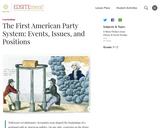
Fear of factionalism and political parties was deeply rooted in Anglo-American political culture before the American Revolution. Leaders such as George Washington and Thomas Jefferson hoped their new government, founded on the Constitution, would be motivated instead by a common intent, a unity. But political parties did form in the United States, with their beginnings in Washington's cabinet.

This interactive Flash game provides an opportunity for a player to make decisions and develop strategic thinking by analyzing the uncovered number choices on a game board that includes the integers from -5 to 12. Each player rolls the dice, chooses which number to begin with and whether to add or subtract the other number to produce either a negative or positive result shown on the board. The goal is to be first player to complete a row of three counters either horizontally, vertically or diagonally on the game board. The Teachers' Notes page offers suggestions for implementation, discussion questions, ideas for support, printable instructions and game board, and a link to a more advanced version of the game (Connect Three, cataloged separately).

This is a lesson plan was created to help librarians and first grade teachers teach their students about research. The format is note taking and a Power Point presentation.

This is a lesson plan was created to help librarians and first grade teachers teach their students about research. The format is note taking and a Power Point presentation. cover page photo credit = File:Mammal Diversity (Placentalia).png - Wikimedia Commons

Family Literacy Videos targeted for families with first grade students. The videos show families engaging their child in evidence-based literacy activities. The video playlist and corresponding document outlining the topics align with IES Practice Guides "A Kindergarten Teacher's Guide to Supporting Family Involvement in Foundational Reading Skills" and "Foundational Skills to Support Reading for Understanding in Kindergarten through Third Grade."
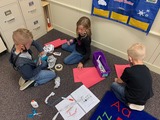
This lesson plan revolves around Genius Hour. It is meant for K-2 grade to teach students how to learn about something using Genius Hour. This lesson requires the whole class to pick a question revolving around how living things survive. They will complete the research, creation, and presentation together as a class. This will allow students to be able to complete their own project using a different question. Thumbnail Image Citation: Image created by Morgan Underwood, Image taken by Morgan Underwood
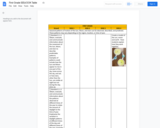
DOK matrices for Grades K, 1, 2, 4, and 5 for the SEEd Standards.
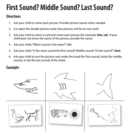
This resource from the Institute for Education Sciences helps teachers and parents build children's phonemic awareness by having children identifying the sound and its' position within the word that is the same in two pictures (ex: dog and duck have the same sound in the initial position of the word). This resources provides directions on how to engage in this phonemic awareness activity with children.
This lesson assesses how much the students know concerning first-aid and then continues on, giving them real life examples to figure out what to do in emergency situations. They will present their findings to the class. The lesson concludes with a post-test to see how much they learned.

UNESCO has published the Beijing Consensus on Artificial Intelligence (AI) and Education, the first ever document to offer guidance and recommendations on how best to harness AI technologies for achieving the Education 2030 Agenda. It was adopted during the International Conference on Artificial Intelligence and Education, held in Beijing from 16-18 May 2019, by over 50 government ministers, international representatives from over 105 Member States and almost 100 representatives from UN agencies, academic institutions, civil society and the private sector.

This three-act math task utilizes videos and questioning to help students explore volume.

Includes suggestions for how to increase student engagement and participation during class discussions.
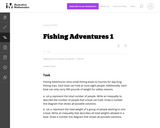
This task is the first in a series of three tasks that use inequalities in the same context at increasing complexity in 6th grade, 7th grade and in HS algebra. Students write and solve inequalities, and represent the solutions graphically.
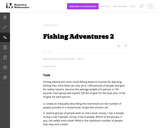
This task is the second in a series of three tasks that use inequalities in the same context at increasing complexity in 6th grade, 7th grade and in HS algebra. Students write and solve inequalities, and represent the solutions graphically.
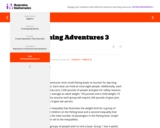
This task is the last in a series of three tasks that use inequalities in the same context at increasing complexity in 6th grade, 7th grade and in HS algebra. Students write and solve inequalities, and represent the solutions graphically.
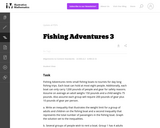
This task is the last in a series of three tasks that use inequalities in the same context at increasing complexity in 6th grade, 7th grade and in HS algebra. Students write and solve inequalities, and represent the solutions graphically. The progression of the content standards is 6.EE.8 to 7.EE.4 to A-REI.12.

In this video segment from Evolution: "Great Transformations," paleontologist Jenny Clack explains that vertebrates evolved fingers before they invaded land.
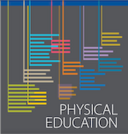
This home exercise program for girls PE is a great way to motivate students to exercise outside of school and get rewarded for it.

Provides in depth information on the components of fitness and how to apply them in your own life. Reading this book will provide the reader with a more advanced knowledge making them a more effective teacher.